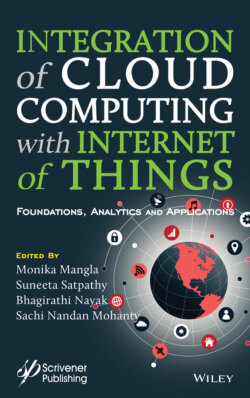Читать книгу Integration of Cloud Computing with Internet of Things - Группа авторов - Страница 15
1.2 The IoT Scenario
ОглавлениеIn recent years, the IoT domain has been extended to provide enhanced tags to monitor and control the human affective states. Such attempts can be found useful in the field of criminal investigations, lie detection, an advanced warning to in-car board systems, on-line tutoring, computer games, security, banking, human resource planning, call centers, child psychology, etc. [4–9]. The associated devices and technologies can be effectively utilized in systems such as voice control, pacemakers, advanced hearing aids, Fitbit electronic wristbands, wearable sensors for the people having sight or mobility disabilities. The use of actuators or sensors to cope with an immediate seizure or a sudden fall or similar emergency can help people or patients of all ages in the home and work environment [10]. The additional security devices mounted on the body or its part will alert nearby individuals including the health attendants or medicos at the right time hence can enhance the quality of living being.
An effective IoT framework in commercial applications requires the collection, analyzing, monitoring, and management of input data concerned with healthcare, medical, transportation, building, home automation, vehicles including agriculture. Elaborate research, control, and monitoring of these inputs can lead to new information and insights for channelizing in the desired directions. A reliable system can provide the desired freedom by linking the smart systems or devices, healthcare services, physicians, and medical resources to patients [11]. Another interesting application is to set-up smart beds in healthcare units equipped with actuators and sensors that provide patient information regularly and also to confirm whether a bed is vacated or occupied. These beds fitted with automatic sensors with appropriate supporting and pressure devices can either reduce or eliminate manual assistance to unwell individuals.
The application of IoT in the transportation system requires an efficient framework to communicate, integrate, process, and control information among many sensors and devices connected to such a system and its peripheries. The role of IoT remains vital to interact and coordinate among traffic systems, logistics and packaging systems, vehicle control, parking, toll plaza, security and safety, road assistance, etc. [12]. Similarly, IoT-based smart infra-structure systems that design and develop smart homes or apartments or campuses or a smart city must be able to manage and control the electrical/electronic/mechanical sensors, actuators, devices, and equipment as per a user demand [13]. Further, such a technology finds its place in several service-based industries, infrastructure development, product or manufacturing industries, metropolitan scale development, agriculture, energy management, living laboratories, environmental monitoring, intelligence, and security, etc.
